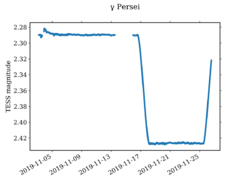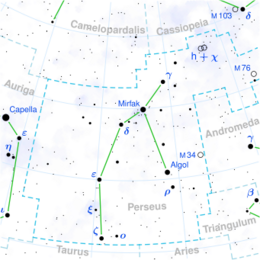Astronomy:Gamma Persei
| Observation data Equinox J2000.0]] (ICRS) | |
|---|---|
| Constellation | Perseus |
| Right ascension | 03h 04m 47.79074s[1] |
| Declination | +53° 30′ 23.1687″[1] |
| Apparent magnitude (V) | 2.93[2] |
| Characteristics | |
| Spectral type | G8III + A2V[3] |
| U−B color index | +0.45[2] |
| B−V color index | +0.70[2] |
| Variable type | EA[4] |
| Astrometry | |
| Radial velocity (Rv) | +2.5[5] km/s |
| Proper motion (μ) | RA: +0.51[1] mas/yr Dec.: –5.92[1] mas/yr |
| Parallax (π) | 13.41 ± 0.51[1] mas |
| Distance | 243 ± 9 ly (75 ± 3 pc) |
| Absolute magnitude (MV) | –1.50[6] (–1.23/0.01)[7] |
| Orbit[7] | |
| Period (P) | 14.6 yr |
| Semi-major axis (a) | 0.144″ |
| Eccentricity (e) | 0.785 |
| Inclination (i) | 90.9° |
| Longitude of the node (Ω) | 244.1° |
| Periastron epoch (T) | 1991.08 Besselian |
| Argument of periastron (ω) (secondary) | 170.0° |
| Details | |
| γ Per A | |
| Mass | 2.7[7] M☉ |
| Surface gravity (log g) | 2.83[8] cgs |
| Temperature | 5,170[8] K |
| Metallicity [Fe/H] | –0.19[8] dex |
| Rotation | 5,350 days[6] |
| Rotational velocity (v sin i) | 50.0[6] km/s |
| γ Per B | |
| Mass | 1.65[7] M☉ |
| Temperature | 7,895[7] K |
| Other designations | |
| Database references | |
| SIMBAD | data |
Gamma Persei (Gamma Per, γ Persei, γ Per) is a binary star system in the constellation Perseus. The combined apparent visual magnitude of the pair is +2.9,[2] making it the fourth-brightest member of the constellation. The distance to this system has been measured using the parallax technique, giving an estimate of roughly 243 light-years (75 parsecs) with a 4% margin of error.[1] About 4° to the north of Gamma Persei is the radiance point for the annual Perseid meteor shower.[9]

This is a wide eclipsing binary system with an orbital period of 5,329.8 days (14.6 years).[10] This eclipse was first observed in 1990 and lasted for two weeks.[11] During an eclipse, the primary passes in front of the secondary, causing the magnitude of the system to decrease by 0.55.[12] The primary component of this system is a giant star with a stellar classification of G9 III.[13] It has a projected rotational velocity of 50.0 km s−1 and a lengthy estimated rotation period of 14.6 years.[6] The classification of the secondary remains tentative, with assignments of A3 V[7] and A2(III).[13]
Mass estimates for the two stars remain disparate. Using speckle interferometry, McAlister (1982) obtained mass estimates of 4.73 M☉ for the primary and 2.75 M☉ for the secondary, where M☉ is the mass of the Sun. He noted that the mass estimate was too high for the given classification of the primary.[14] Martin and Mignard (1998) determined masses for both components based on data from the Hipparcos mission: 5.036 ± 0.951 M☉ for the primary and 2.295 ± 0.453 M☉ for the secondary. They admit that the high inclination of the orbit resulted in a large margin of error.[15] Prieto and Lambert (1999) came up with a mass estimate of 3.81 M☉ for the primary,[16] while Pizzolato and Maggio (2000) obtained 4.34 M☉.[6] Ling et al. (2001) obtained estimates of 2.7 M☉ for the primary and 1.65 M☉ for the secondary,[7] while Kaler (2001) obtained 2.5 and 1.9, respectively.[11]
Name and etymology
- This star, together with δ Per, ψ Per, σ Per, α Per and η Per, has been called the Segment of Perseus.[17]
- In Chinese, 天船 (Tiān Chuán), meaning Celestial Boat, refers to an asterism consisting of γ Persei, η Persei, α Persei, ψ Persei, δ Persei, 48 Persei, μ Persei and HD 27084. Consequently, the Chinese name for γ Persei itself is 天船二 (Tiān Chuán èr, English: the Second Star of Celestial Boat.)[18]
References
- ↑ 1.0 1.1 1.2 1.3 1.4 1.5 van Leeuwen, F. (November 2007), "Validation of the new Hipparcos reduction", Astronomy and Astrophysics 474 (2): 653–664, doi:10.1051/0004-6361:20078357, Bibcode: 2007A&A...474..653V
- ↑ 2.0 2.1 2.2 2.3 Johnson, H. L. et al. (1966), "UBVRIJKL photometry of the bright stars", Communications of the Lunar and Planetary Laboratory 4 (99): 99, Bibcode: 1966CoLPL...4...99J
- ↑ Malkov, O. Yu.; Tamazian, V. S.; Docobo, J. A.; Chulkov, D. A. (2012). "Dynamical masses of a selected sample of orbital binaries". Astronomy & Astrophysics 546: A69. doi:10.1051/0004-6361/201219774. Bibcode: 2012A&A...546A..69M.
- ↑ Samus, N. N. et al. (2009). "VizieR Online Data Catalog: General Catalogue of Variable Stars (Samus+ 2007-2013)". VizieR On-line Data Catalog: B/GCVS. Originally Published in: 2009yCat....102025S 1. Bibcode: 2009yCat....102025S.
- ↑ Wilson, Ralph Elmer (1953), "General Catalogue of Stellar Radial Velocities", Washington (Washington: Carnegie Institution of Washington), Bibcode: 1953GCRV..C......0W
- ↑ 6.0 6.1 6.2 6.3 6.4 Pizzolato, N.; Maggio, A.; Sciortino, S. (September 2000), "Evolution of X-ray activity of 1-3 Msun late-type stars in early post-main-sequence phases", Astronomy and Astrophysics 361: 614–628, Bibcode: 2000A&A...361..614P
- ↑ 7.0 7.1 7.2 7.3 7.4 7.5 7.6 Ling, J. F.; Magdalena, P.; Prieto, C. (October 2001), "Perturbations by Mass Loss in the Orbital Elements of γ Persei and α Centauri", Revista Mexicana de Astronomía y Astrofísica 37: 179–186, Bibcode: 2001RMxAA..37..179L
- ↑ 8.0 8.1 8.2 McWilliam, Andrew (December 1990), "High-resolution spectroscopic survey of 671 GK giants", Astrophysical Journal Supplement Series 74: 1075–1128, doi:10.1086/191527, Bibcode: 1990ApJS...74.1075M
- ↑ Burnham, Robert (1978), Burnham's celestial handbook: an observer's guide to the universe beyond the solar system, Dover books explaining science, 3 (2nd ed.), Courier Dover Publications, p. 420, ISBN 0486236730, https://books.google.com/books?id=PJzIt3SIlkUC&pg=PA1420
- ↑ Pourbaix, D.; Boffin, H. M. J. (February 2003), "Reprocessing the Hipparcos Intermediate Astrometric Data of spectroscopic binaries. II. Systems with a giant component", Astronomy and Astrophysics 398 (3): 1163–1177, doi:10.1051/0004-6361:20021736, Bibcode: 2003A&A...398.1163P
- ↑ 11.0 11.1 Kaler, James B. (January 5, 2001), "GAMMA PER (Gamma Persei)", Stars (University of Illinois), http://stars.astro.illinois.edu/sow/gammaper.html, retrieved 2012-02-25
- ↑ Malkov, O. Yu. et al. (February 2006), "A catalogue of eclipsing variables", Astronomy and Astrophysics 446 (2): 785–789, doi:10.1051/0004-6361:20053137, Bibcode: 2006A&A...446..785M
- ↑ 13.0 13.1 Ginestet, N.; Carquillat, J. M. (December 2002), "Spectral Classification of the Hot Components of a Large Sample of Stars with Composite Spectra, and Implication for the Absolute Magnitudes of the Cool Supergiant Components", The Astrophysical Journal Supplement Series 143 (2): 513–537, doi:10.1086/342942, Bibcode: 2002ApJS..143..513G
- ↑ McAlister, H. A. (March 1982), "Masses and luminosities for the giant spectroscopic/speckle interferometric binaries gamma Persei and phi Cygni", Astronomical Journal 87: 563–569, doi:10.1086/113130, Bibcode: 1982AJ.....87..563M
- ↑ Martin, C.; Mignard, F. (February 1998), "Mass determination of astrometric binaries with Hipparcos. II. Selection of candidates and results", Astronomy and Astrophysics 330: 585–599, Bibcode: 1998A&A...330..585M
- ↑ Allende Prieto, C.; Lambert, D. L. (1999), "Fundamental parameters of nearby stars from the comparison with evolutionary calculations: masses, radii and effective temperatures", Astronomy and Astrophysics 352: 555–562, doi:10.1051/0004-6361/200811242, Bibcode: 1999A&A...352..555A
- ↑ Allen, R. H. (1963). Star Names: Their Lore and Meaning (Reprint ed.). New York: Dover Publications Inc.. p. 331. ISBN 0-486-21079-0. https://archive.org/details/starnamestheirlo00alle/page/331. Retrieved 2012-09-04.
- ↑ (in Chinese) AEEA (Activities of Exhibition and Education in Astronomy) 天文教育資訊網 2006 年 7 月 11 日
 |


